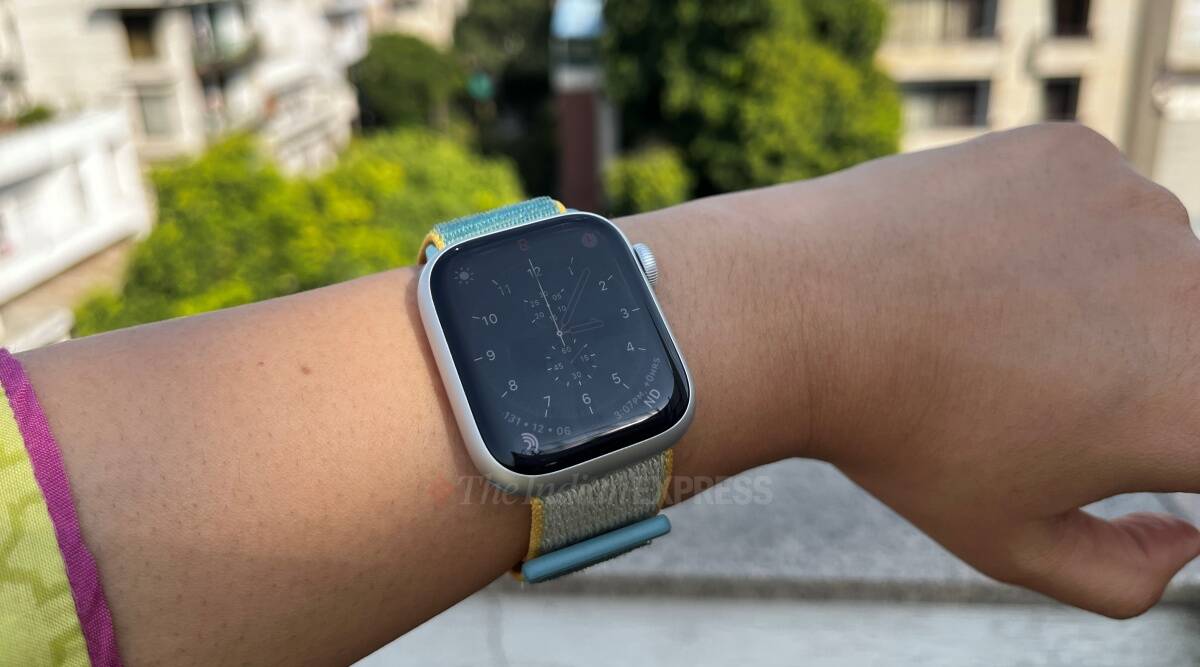
(Image Credits:- Shruti Dhapola/Indian Express/WideCare)
If you didn’t know, Apple has for the past few years been the world’s largest watch company. It has also started creating product lines similar to watch companies where models don’t really change with time as it does in the smartphone industry. This could be why the Apple Watch Series 8 doesn’t appear to be much of an upgrade in comparison to last year’s Series 7. Other than the temperature sensor, there’s not much that’s changed in terms of the hardware and design. But for someone like me, who has used an Apple Watch Series 3 for nearly five years, the Watch Series 8 was a much-needed upgrade. After having used this for nearly two weeks, here’s my review.
Apple Watch Series 8 specifications:
Always-On Retina LTPO OLED display, 41mm: 352 by 430 pixels, 45mm: 396 by 484 pixels, up to 1000 nits brightness | S8 with 64-bit dual-core processor with 32GB storage space | W3 Apple wireless chip | U1 chip (Ultra Wideband) | Wi-Fi 802.11b/g/n 2.4GHz and 5GHz | Bluetooth 5.3 | Up to 18 hours battery life | USB-C magnetic fast charging cable| GPS: L1 GPS, GLONASS, Galileo, QZSS, and BeiDou | Up to 256 g-forces with Fall Detection and Crash Detection |
Apple Watch Series 8 price in India:
Rs 45,900 for the 41mm version
Apple Watch Series 8: What’s different, does that temperature sensor work for everyone?
The key feature of the Series 8 for me is the new temperature sensor which is supposed to help detect the body’s basal temperature. This is new to the Apple Watch and available only on Series 8 and the Ultra. The feature helps improves menstruation cycle tracking for women by alerting them about their possible ovulation dates, claims Apple.
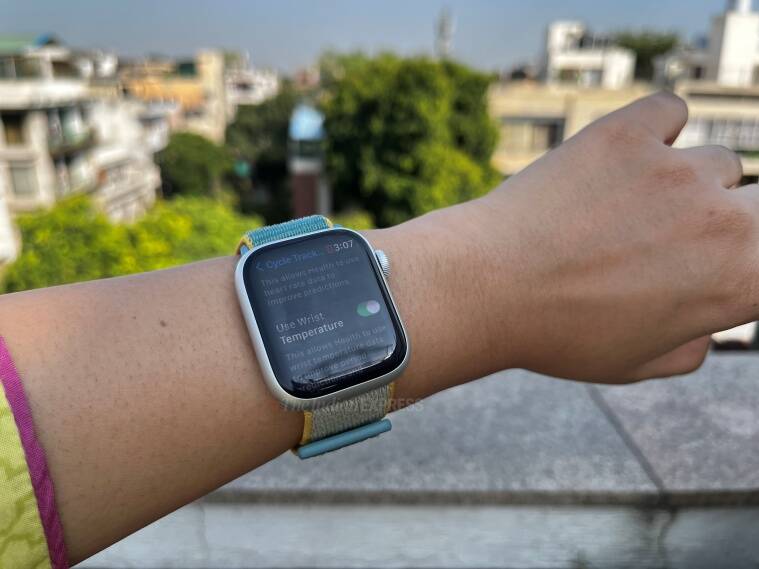
(Image Credits:- Shruti Dhapola/Indian Express/WideCare)
Apple is using two sensors for this; one located at the back of the watch near the skin and a second one under the display. Basal temperature, or body temperature when at rest, shows a slight increase soon after ovulation. Sometimes the rise is less than 0.5 degrees Fahrenheit. Further, factors such as stress, jet lag, lack of sleep, etc, also impact basal body temperature.
The temperature sensor is not meant to test body temperature if you suspect you have a fever. It is not calculated in real-time. But if you are using this on a daily basis, you will get some indication as the Health app does let you see the temperature data at length. This works for men as well. Maybe Apple could expand the sensor’s use case in the future, but that’s something the company has not confirmed or spoken about for now.
You need to wear the watch at night to sleep for Apple to accurately detect this basal temperature. The Watch needs to work for a minimum of five nights for the data to start showing. Keep in mind that Apple is giving retrospective data on ovulation. This should not be used as a method of birth control in any way. An actual ovulation test will be the more accurate way to keep a track of this.
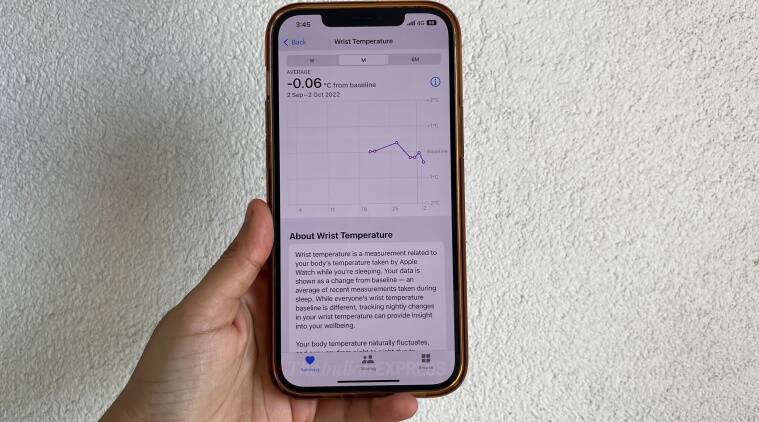
(Image Credits:- Shruti Dhapola/Indian Express/WideCare)
Apple Watch Series 8: What I liked?
I admit that one reason I held on to the Apple Watch Series 3 for so long was the 38mm screen size, which is a perfect fit for my wrists. I was worried that the 41mm would look too big– the 45mm I knew would be too big– but I was wrong. It fits quite well, and it’s not heavier either. I have the 41mm in silver in aluminium with the sports band, which looks stylish.
The bigger screen size compared to the older Series 3, means more space to view content. But again this is not much of a change for someone on the existing Series 7. That said, regular users don’t really see changes in watches every year. Of course, the Apple Watch fulfils a lot of smart functions and remains ahead of its rivals. From replying to WhatsApp notifications and text messages to taking calls, this is a smartwatch that fulfils every single function without slowing down.
What also impressed me was the battery life. And this is when I’ve been wearing the watch at night as well, during my sleep hours. Apple promises around 18 hours of battery life. But even with 40 minutes of workout, notifications coming, etc you should easily get by with charging every alternate day or so. There’s also a new Low Power mode on WatchOS 9, which ensures you can extend the battery life further, while still doing workouts, etc, though some other functions such as Always On display, Blood oxygen monitoring get turned off.
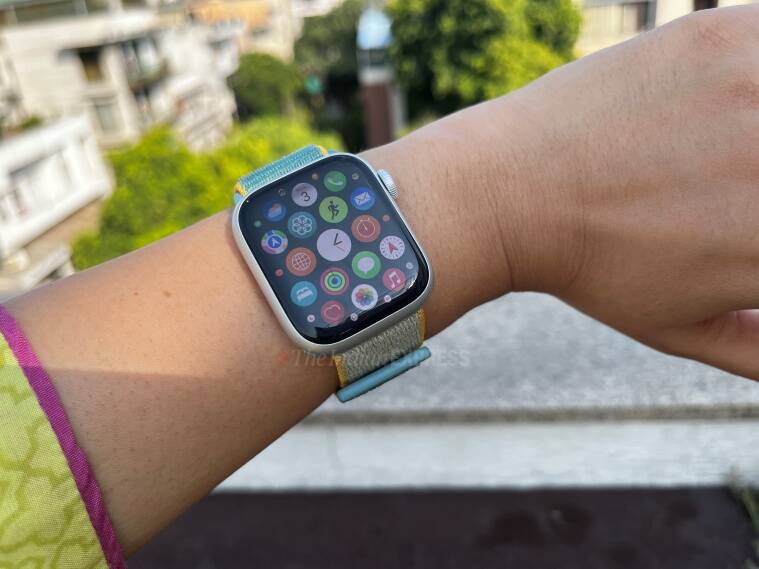
(Image Credits:- Shruti Dhapola/Indian Express/WideCare)
Another aspect that you have to appreciate about the Apple Watch is the sheer number of third-party band options which are available. Many of these cost much less than the official Apple bands. This customisation choice is something customers will appreciate. I’ve already bought two from a third-party and intend to try some more from other brands.
When it comes to fitness and health, the Apple Watch Series 8 remains one of the most comprehensive devices you can carry on your person. First, let’s talk about the temperature sensor and the ovulation data. Setting it up was easy, though you need to make sure you already have Cycle tracking and Sleep focus turned on your iPhone and Apple Watch.
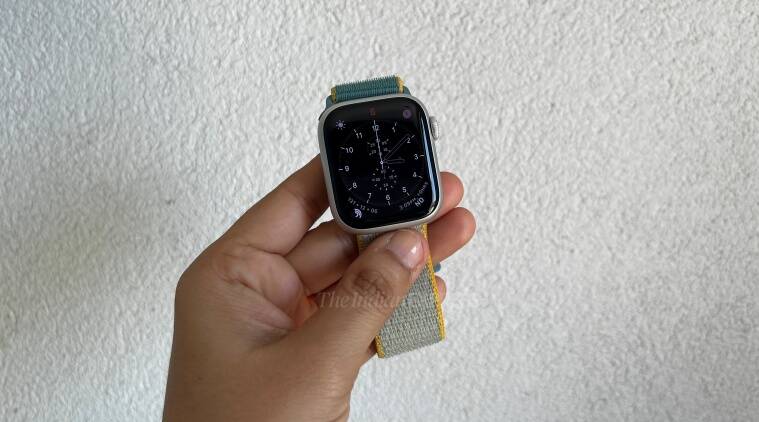
(Image Credits:- Shruti Dhapola/Indian Express/WideCare)
You will need to switch on Sleep focus on the Watch itself when sleeping for the temperature data to get collected. I didn’t turn on Sleep focus for some nights, hence the basal temperature did not show up on the Watch and I was confused as to why it kept happening. That said, I’m not a fan of wearing any watch to bed.
After five nights, with the Sleep focus turned on, the data appears in the Health app. One can see the wrist temperature as an option in the Body Measurements segment of the app. In my case, it shows a slight drop in basal body temperature (around 0.41-degree celsius) which is typically an indicator that my period is about to arrive. Going by the past cycles, I would say this is accurate as I’m closer to my period data right now. Apple will also show the recorded data for each day. I will have to wait and see how accurate the ovulation predictions are and how these are based, but keep in mind that this data is retrospective.
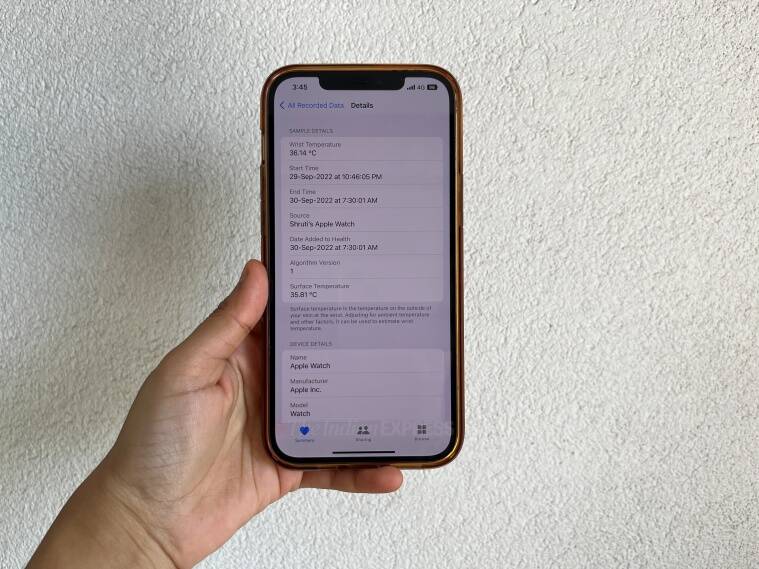
(Image Credits:- Shruti Dhapola/Indian Express/WideCare)
But this data could certainly serve as another useful indicator for women who might not have the most regular period cycle. For some of us, ovulation comes with its own indicators– such as bloating, especially common if you have PCOS. The data when linked with other symptoms or discomfort could help women gain a better sense of the cycle, and perhaps even start some conversations with their doctors. Very often women find their symptoms ignored by doctors but perhaps clubbed with data it might make for a more persuasive case.
Of course, Apple remains the best option when it comes to other forms of exercise and workouts. I admit it is a nice feeling when you close those Apple rings for the day. But the Series 8 is also capable of ECG and detecting blood oxygen, which I’ve not had a chance to check out to date. The ECG feature is not something everyone needs, but might be relevant in this post-COVID world, where many of us have seen our physical health take a hit.
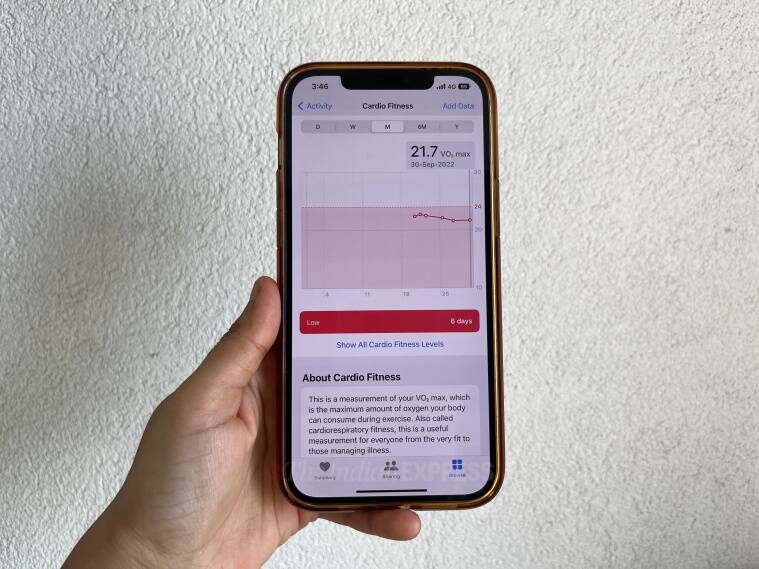
(Image Credits:- Shruti Dhapola/Indian Express/WideCare)
One thing I did notice was that Apple Watch warned me that I had ‘Low Cardio’ fitness after a walk/short jog I had taken. This is based on VO2 max, which is the ‘maximum amount of oxygen one’s body can consume during exercise. Yes, Apple is giving only an estimate. Still, it was interesting that Apple warned me of something that I’ve been worried about. I definitely feel my cardio fitness is poorer post-Covid, but quantifying this is so much harder. Exercises which never left caused a spike, now ensure that my heart-rate crosses 140 to 150 easily. So when Apple indicated poor cardio fitness, I would say I wasn’t surprised. Of course, this is something that can be improved with regular exercise as well.
The Series 8 can also detect loud sounds and noise, which might be detrimental to our hearing. So far it has been absolutely accurate in detecting these. The first time, it warned me when my dog was barking for a long time. The second time, I got an alert when my toddler was bawling during his vaccination session. Those alerts were definitely eye-opening.
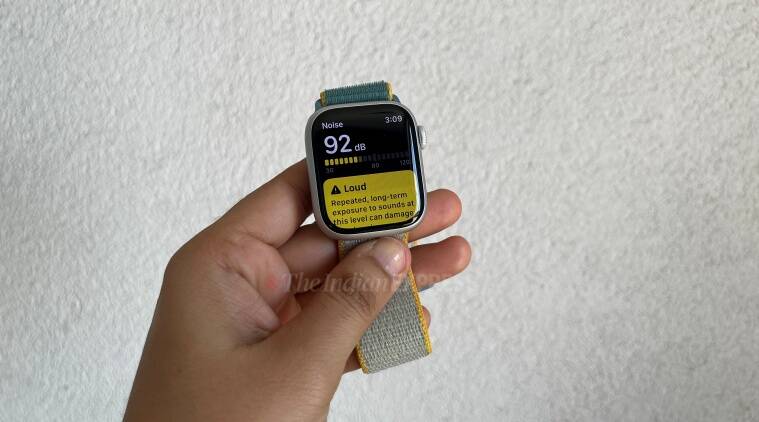
(Image Credits:- Shruti Dhapola/Indian Express/WideCare)
Apple Watch Series 8: What I didn’t like?
The Apple Watch Series 8 is also capable of detecting when you’re washing hands and is supposed to turn on the 20-second timer. I have this feature turned on, but so far it has shown the timer twice when washing hands while the watch was on. I’m not sure why the detection hasn’t shown up during other hand-washing sessions. Other than that I’ve not noticed any issues with the Watch Series 8 as such.
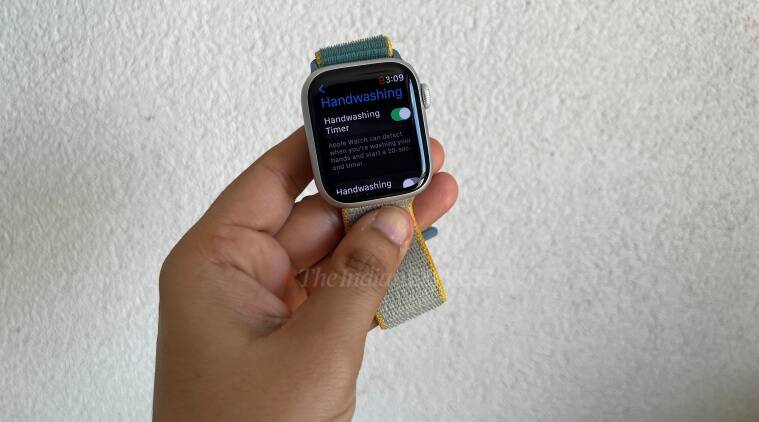
(Image Credits:- Shruti Dhapola/Indian Express/WideCare)
Apple Watch Series 8: Who should upgrade?
The Apple Watch Series 8– like previous generations– remains the smartwatch to beat for other brands. And I say this as someone who has used countless fitness watches across various price segments. If you are an iPhone user and have been wondering if it is time to get an Apple Watch, the Series 8 is certainly an excellent choice. If you’ve been holding on to the Series 3 like me, it might be time to upgrade. Of course, one can always consider the Watch SE 2 since it is more affordable and for younger folks, it is the practical choice.
But if you’re someone who is more conscious about their health and doesn’t mind paying for the extra sensors such as the temperature one, ECG, and blood oxygen monitoring, then it makes sense to get the Series 8. For users with a Series 7 or Series 6, they should ideally wait it out.
News Article Source:- Indian Express



Recent Comments